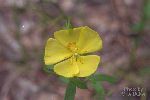

in the identification window
not in this instruction window.
There are two PROCESS buttons, one is near the top and the other is near the bottom of the page. They both perform exactly the same function. These buttons are used to "send" the information that you have marked to the host computer. The program (in the host computer) does not know what traits you have marked until you press a PROCESS button.
Under the top PROCESS button and between the next two horizontal lines, there are four control function settings. The only control function that is initially of interest is the last one, "RESET THE KEY". This is used to reset the key and restart it at the beginning. Mark this Yes and press the Process button to reinitialize the key.
The main area is comprised of two types of lines, lines that have ONLY black letters and lines that have black letters AND blue underlined links.
The EXIT button is at the bottom of the form.

 |
in the identification window not in this instruction window. |
Let's identify the plant pictured above. Look at the picture and choose the most obvious characteristic. The most obvious characterstic, to me, is the YELLOW flower. Press CNTRL & F to open the browser FIND window. When it opens, type in YELLOW and press the FIND button. After it has found the correct characteristic, click on the leftmost hole in the same row and left of yellow flowers. The little black mark will jump from the 'unmarked' hole to the hole that you just clicked, the YES hole. After marking yellow flowers as a YES, now with the mouse, grab the slider button at the right of the screen and pull it up until you see the PROCESS button near the top of the page. When you see the PROCESS button, release the slider button and click on the PROCESS button. The Yes mark that you just added is now sent to the program and the program revises the screen eliminating all the items that cannot apply for a yellow flowered plant and sends you back a much, much shorter, revised screen.
Now we perform the same process with the next most obvious characteristic. To me, the next most obvious characteristic is that the the flower has five petals. The list is now short enough so that you don't need to use the browser FIND function but can find what you want by scanning through the list. Grab the slider button at the right of the screen (with the mouse) and pull it down until you see 5 Petals. Place a Yes mark and press a PROCESS button.
The next most obvious characteristic is the Alternate Leaves. Place a Yes mark and press a Process button.
Now, most of the lines (and possible plant names) have been eliminated. The remaining lines that have blue underlined letters are plants that have the characteristics specified. Between the remaining plants, an easy isolating trait is the blossom size. The above pictures do not however provide size reference keys so you may not know this information just as you may be missing a key trait on a real inquiry. If the remaining plants have underlined scientific name links, try clicking on them to see if one might be the plant you are trying to identify.
What we did:
The user should be careful to only mark traits that are characteristic of the species in general and not just characteristics of only one plant! For example, say you try to identify a 10 inch high plant that is in fact, a baby tree. The definition for that tree might include a height characteristic of say, 50 feet. If we mark 'Yes' to the less than 3 feet characteristic, that eliminates all plants which are more than 3 feet which, of course, eliminates the tree name that we are trying to find! It is sometimes difficult to determine if a characteristic that we see in one plant is characteristic of the species in general or only of this single individual plant. Many times there are multiple individuals of a plant in a local area. Looking for other plants in the area and confirming that characteristics are consistant across multiple individuals can save considerable frustration. If a characteristic is questionable, initially, skip it and try to find another characteristic that you are sure will be representative of the species. These "questionable" characteristics may well be useful later in the process for confirmation or for "fine tuning" the characteristic list.
The reason to only mark one trait at a time is to let the program do the work and eliminate the impossible choices. On a reset, the program begins with more than 1000 possibility lines, not all of which are displayed. The first mark processed will typically eliminate hundreds, which is much easier than manually eliminating those same hundreds of lines, yes?
There is no "undo" function. Users have the ability to fix any mistakes by resetting the key and reworking the inquiry.
Further, I have attempted to allow for what I term a humanistic approach. When I, as a human, see an oak leaf, I immediately start to observe the leaf characteristics to determine the species. I do NOT revert to asking if it is a coniferous or deciduous tree! I already know that information and a lot more when I see the broad leaf. I built similar 'intrinsic knowledge' into the program. In the example above, where the plant has a yellow flower, the program is able to inherently 'know' that the plant does NOT have a blue flower etc. Further, if it has a flower, it is a member of the flowering plant group which automatically eliminates the entire non-flowering plant group, etc!
I hope you enjoy this program.